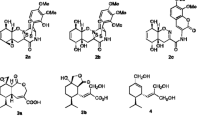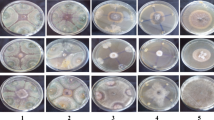Abstract
The oomycetes of the genus Phytophthora have the most aggressive species for agriculture and forestry, such as Phytophthora sojae which is responsible for soybean root rot, Phytophthora infestans responsible for the potato downy mildew that caused the diaspora in Ireland in the nineteenth-century, and Phytophthora cinnamomi that affects a wide variety of tree species, from avocado in America, trees in Oceania to European chestnut trees. P. cinnamomi reproduces either sexually or asexually and asexual zoospores can live as saprotrophs and subsist in the soil long after death and removal of host plants. Controlling this organism is very challenging for researchers due to the limited range of effective chemical inhibitors. In this work, we present a systematic review of alternatives for biocontrol of Phytophthora in general and P. cinnamomi in particular. Our literature review indicates that Trichoderma spp., mainly Trichoderma harzianum, T. virens, and T. asperellum are very promising fungal species in the control of different Phytophthora spp. The Bacillus genus is also very promising in the control and inhibition of several Phytophthoras spp.

Similar content being viewed by others
Availability of data and materials
Not applied.
References
Hardham AR, Blackman LM (2018) Phytophthora cinnamomi. Mol Plant Pathol 19:260–285. https://doi.org/10.1111/mpp.12568
Lourenço D, de Leon A, de Santos PMM, Choupina L AB (2019) Fatores moleculares associados com a patogenicidade de Phytophthora cinnamomi. Rev Ciências Agrárias 4:1059–1070. https://doi.org/10.19084/rca.18577
Brown MS, Baysal-Gurel F, Oliver JB, Addesso KM (2019) Comparative performance of fungicides, biofungicides, and host plant defense inducers in suppression of phytophthora root rot in flowering dogwood during simulated root flooding events. Plant Dis 103:1703–1711. https://doi.org/10.1094/PDIS-09-18-1597-RE
Kozlowski TT (1997) Responses of woody plants to flooding and salinity. Tree Physiol 17:490–490. https://doi.org/10.1093/treephys/17.7.490
Brown MS, Baysal-Gurel F, Oliver JB, Addesso KM (2019) Evaluation of fungicides and biofungicide to control Phytophthora root rot (Phytophthora cinnamomi Rands) and ambrosia beetles (Coleoptera: Curculionidae: Scolytinae) on flowering dogwoods exposed to simulated flood events. Crop Prot 124:104834. https://doi.org/10.1016/j.cropro.2019.05.028
You MP, Lamichhane JR, Aubertot JN, Barbetti MJ (2020) Understanding why effective fungicides against individual soilborne pathogens are ineffective with soilborne pathogen complexes. Plant Dis 104:904–920. https://doi.org/10.1094/PDIS-06-19-1252-RE
Tomah AA, Abd Alamer IS, Li B, Zhang JZ (2020) A new species of Trichoderma and gliotoxin role: A new observation in enhancing biocontrol potential of T. virens against Phytophthora capsici on chili pepper. Biol Control 145:104261. https://doi.org/10.1016/j.biocontrol.2020.104261
Belisle RJ, Hao W, McKee B et al (2019) New oomycota fungicides with activity against phytophthora cinnamomi and their potential use for managing avocado root rot in California. Plant Dis 103:2024–2032. https://doi.org/10.1094/PDIS-09-18-1698-RE
Müller U, Gisi U (2012) Newest Aspects of Nucleic Acid Synthesis Inhibitors: Metalaxyl-M. Modern Crop Protection Compounds. Wiley-VCH Verlag GmbH & Co. KGaA, Weinheim, Germany, pp 901–908
Je A, Hao W, Gray M (2016) Potassium Phosphite Resistance and New Modes of Action for Managing. Phytophthora Diseases of Citrus in the United States
Gisi U, Sierotzki H (2015) Oomycete Fungicides: Phenylamides, Quinone Outside Inhibitors, and Carboxylic Acid Amides. In: Fungicide Resistance in Plant Pathogens. Springer Japan, pp 145–174
Mandal A, Sarkar B, Mandal S et al (2020) Impact of agrochemicals on soil health. Agrochemicals Detection, Treatment and Remediation. Elsevier, pp 161–187
Sukul P (2006) Enzymatic activities and microbial biomass in soil as influenced by metalaxyl residues. Soil Biol Biochem 38:320–326. https://doi.org/10.1016/j.soilbio.2005.05.009
Monkiedje A, Ilori MO, Spiteller M (2002) Soil quality changes resulting from the application of the fungicides mefenoxam and metalaxyl to a sandy loam soil. Soil Biol Biochem 34:1939–1948. https://doi.org/10.1016/S0038-0717(02)00211-0
Köhl J, Kolnaar R, Ravensberg WJ (2019) Mode of Action of Microbial Biological Control Agents Against Plant Diseases: Relevance Beyond Efficacy. Front Plant Sci 10:845. https://doi.org/10.3389/fpls.2019.00845
Higgins J, Thomas J, Chandler J et al (2021) Cochrane Handbook for Systematic Reviews of Interventions version 6.2 (updated February 2021). Cochrane, 2021
Moher D, Liberati A, Tetzlaff J, Altman DG (2009) Preferred Reporting Items for Systematic Reviews and Meta-Analyses: The PRISMA Statement. PLoS Med 6:e1000097. https://doi.org/10.1371/journal.pmed.1000097
Vega F (2018) The use of fungal entomopathogens as endophytes in biological control: a review. Mycologia 110:4–30. https://doi.org/10.1080/00275514.2017.1418578
Bamisile BS, Dash CK, Akutse KS et al (2018) Prospects of endophytic fungal entomopathogens as biocontrol and plant growth promoting agents: An insight on how artificial inoculation methods affect endophytic colonization of host plants. Microbiol Res 217:34–50. https://doi.org/10.1016/J.MICRES.2018.08.016
Yao Y, Li Y, Huang Z et al (2016) Targeted selection of Trichoderma antagonists for control of pepper Phytophthora blight in China. J Plant Dis Prot 123:215–223. https://doi.org/10.1007/s41348-016-0025-0
Nawaz K, Shahid AA, Bengyella L et al (2018) Diversity of Trichoderma species in chili rhizosphere that promote vigor and antagonism against virulent Phytophthora capsici. Sci Hortic (Amsterdam) 239:242–252. https://doi.org/10.1016/j.scienta.2018.05.048
Mousumi Das M, Haridas M, Sabu A (2019) Biological control of black pepper and ginger pathogens, Fusarium oxysporum, Rhizoctonia solani and Phytophthora capsici, using Trichoderma spp. Biocatal Agric Biotechnol 17:177–183. https://doi.org/10.1016/j.bcab.2018.11.021
Sanchez AD, Ousset MJ, Sosa MC (2019) Biological control of Phytophthora collar rot of pear using regional Trichoderma strains with multiple mechanisms. Biol Control 135:124–134. https://doi.org/10.1016/j.biocontrol.2019.05.012
Gu X, Wang R, Sun Q et al (2020) Four new species of Trichoderma in the Harzianum clade from northern China. MycoKeys 73:109. https://doi.org/10.3897/MYCOKEYS.73.51424
Chaverri P, Branco-Rocha F, Jaklitsch W et al (2017) Systematics of the Trichoderma harzianum species complex and the re-identification of commercial biocontrol strains. 558–590. https://doi.org/10.3852/14-147. http://dx.doi.org/103852/14-147 107
Umadevi P, Anandaraj M (2019) Proteomic analysis of the tripartite interaction between black pepper, Trichoderma harzianum and Phytophthora capsici provides insights into induced systemic resistance mediated by Trichoderma spp. Eur J Plant Pathol 154:607–620. https://doi.org/10.1007/s10658-019-01685-3
Widmer TL, Shishkoff N (2017) Reducing infection and secondary inoculum of Phytophthora ramorum on Viburnum tinus roots grown in potting medium amended with Trichoderma asperellum isolate 04–22. Biol Control 107:60–69. https://doi.org/10.1016/j.biocontrol.2017.01.014
Widmer TL, Johnson-Brousseau S, Kosta K et al (2018) Remediation of Phytophthora ramorum-infested soil with Trichoderma asperellum isolate 04–22 under ornamental nursery conditions. Biol Control 118:67–73. https://doi.org/10.1016/j.biocontrol.2017.12.007
Trzewik A, Maciorowski R, Klocke E, Orlikowska T (2020) The influence of Piriformospora indica on the resistance of two rhododendron cultivars to Phytophthora cinnamomi and P. plurivora. Biol Control 140:104121. https://doi.org/10.1016/j.biocontrol.2019.104121
Terhonen E, Sipari N, Asiegbu FO (2016) Inhibition of phytopathogens by fungal root endophytes of Norway spruce. Biol Control 99:53–63. https://doi.org/10.1016/j.biocontrol.2016.04.006
Di Francesco A, Milella F, Mari M, Roberti R (2017) A preliminary investigation into Aureobasidium pullulans as a potential biocontrol agent against Phytophthora infestans of tomato. Biol Control 114:144–149. https://doi.org/10.1016/j.biocontrol.2017.08.010
El-Sayed ASA, Ali GS (2020) Aspergillus flavipes is a novel efficient biocontrol agent of Phytophthora parasitica. Biol Control 140. https://doi.org/10.1016/j.biocontrol.2019.104072
Rajaofera MJN, Jin PF, Fan YM et al (2018) Antifungal activity of the bioactive substance from Bacillus atrophaeus strain HAB-5 and its toxicity assessment on Danio rerio. Pestic Biochem Physiol 147:153–161. https://doi.org/10.1016/j.pestbp.2017.06.006
Guo D, Yuan C, Luo Y et al (2020) Biocontrol of tobacco black shank disease (Phytophthora nicotianae) by Bacillus velezensis Ba168. Pestic Biochem Physiol 165:104523. https://doi.org/10.1016/j.pestbp.2020.01.004
Méndez-Bravo A, Cortazar-Murillo EM, Guevara-Avendaño E et al (2018) Plant growth-promoting rhizobacteria associated with avocado display antagonistic activity against Phytophthora cinnamomi through volatile emissions. PLoS ONE 13:1–18. https://doi.org/10.1371/journal.pone.0194665
Syed-Ab-Rahman SF, Carvalhais LC, Chua E et al (2018) Identification of soil bacterial isolates suppressing different phytophthora spp. And promoting plant growth. Front Plant Sci 871:1–18. https://doi.org/10.3389/fpls.2018.01502
Syed-Ab-Rahman SF, Carvalhais LC, Chua ET et al (2019) Soil bacterial diffusible and volatile organic compounds inhibit Phytophthora capsici and promote plant growth. Sci Total Environ 692:267–280. https://doi.org/10.1016/j.scitotenv.2019.07.061
Sagredo-Beltrán J, De La Cruz-Rodríguez Y, Alvarado-Rodríguez M et al (2018) Genome sequence of Bacillus halotolerans strain MS50- 18A with antifungal activity against phytopathogens, isolated from saline soil in San Luís Potosí, Mexico. Genome Announc 6:1–2. https://doi.org/10.1128/genomeA.00135-18
Bhusal B, Mmbaga MT (2020) Biological control of Phytophthora blight and growth promotion in sweet pepper by Bacillus species. Biol Control 150:104373. https://doi.org/10.1016/j.biocontrol.2020.104373
Kumbar B, Mahmood R, Nagesha SN et al (2019) Field application of Bacillus subtilis isolates for controlling late blight disease of potato caused by Phytophthora infestans. Biocatal Agric Biotechnol 22:101366. https://doi.org/10.1016/j.bcab.2019.101366
Zohara F, Akanda MAM, Paul NC et al (2016) Inhibitory effects of Pseudomonas spp. on plant pathogen Phytophthora capsici in vitro and in planta. Biocatal Agric Biotechnol 5:69–77. https://doi.org/10.1016/j.bcab.2015.12.009
El-Sayed ASA, Akbar A, Iqrar I et al (2018) A glucanolytic Pseudomonas sp. associated with Smilax bona-nox L. displays strong activity against Phytophthora parasitica. Microbiol Res 207:140–152. https://doi.org/10.1016/j.micres.2017.11.018
Thampi A, Bhai RS (2017) Rhizosphere actinobacteria for combating Phytophthora capsici and Sclerotium rolfsii, the major soil borne pathogens of black pepper (Piper nigrum L.). Biol Control 109:1–13. https://doi.org/10.1016/j.biocontrol.2017.03.006
Arfaoui A, Adam LR, Bezzahou A, Daayf F (2018) Isolation and identification of cultivated bacteria associated with soybeans and their biocontrol activity against Phytophthora sojae. Biocontrol 63:607–617. https://doi.org/10.1007/s10526-018-9873-9
Colavolpe MB, Silva M, de Maguire C et al (2020) Antagonistic compounds from controversial bacteria with suppressing effects on the diseases caused by Phytophthora cinnamomi. Arch Phytopathol Plant Prot 53:70–81. https://doi.org/10.1080/03235408.2020.1719007
Anjum MZ, Ghazanfar MU, Hussain I (2019) Bio-Efficacy of trichoderma isolates and bacillus subtilis against root rot of muskmelon cucumis melo L. Caused by phytophthora drechsleri under controlled and field conditions. Pakistan J Bot 51:1877–1882. https://doi.org/10.30848/PJB2019-5(13)
Gilardi G, Pugliese M, Gullino ML, Garibaldi A (2020) Effect of biocontrol agents and potassium phosphite against Phytophthora crown rot, caused by Phytophthora capsici, on zucchini in a closed soilless system. Sci Hortic (Amsterdam) 265:109207. https://doi.org/10.1016/j.scienta.2020.109207
Cucu MA, Gilardi G, Pugliese M et al (2020) Effects of biocontrol agents and compost against the Phytophthora capsici of zucchini and their impact on the rhizosphere microbiota. Appl Soil Ecol 154:103659. https://doi.org/10.1016/j.apsoil.2020.103659
Sumida CH, Fantin LH, Braga K, Canteri MG (2020) Control of root rot (Phytophthora cinnamomi) in avocado (persea americana) with bioagents. Summa Phytopathol 46:205–211. https://doi.org/10.1590/0100-5405/192195
Perez-Alvarez R, Nault BA, Poveda K (2019) Effectiveness of augmentative biological control depends on landscape context. Sci Rep 2019 91 9:1–15. https://doi.org/10.1038/s41598-019-45041-1
Naranjo SE, Ellsworth PC, Frisvold GB (2015) Economic value of biological control in integrated pest management of managed plant systems. Annu Rev Entomol 60:621–645. https://doi.org/10.1146/ANNUREV-ENTO-010814-021005
Acknowledgements
The authors are grateful to the Foundation for Science and Technology (FCT, Portugal) and FEDER under Programme PT2020 for financial support to CIMO (UID/AGR/00690/2019).
Funding
Not applied.
Author information
Authors and Affiliations
Contributions
All authors contributed to the study’s conception and design. Material preparation, data collection, and analysis were performed by Darling de Andrade Lourenço. The first draft of the manuscript was written by Darling de Andrade Lourenço and Altino Choupina and all authors commented on previous versions of the manuscript. Supervision: Altino Branco Choupina.
Corresponding author
Ethics declarations
Conflict of interest
The authors declare that there is no conflict of interest.
Consent for publication
All authors read, approved the final manuscript, and consent for publication.
Ethics approval and consent to participate
Not applied.
Additional information
Publisher’s note
Springer Nature remains neutral with regard to jurisdictional claims in published maps and institutional affiliations.
Rights and permissions
About this article
Cite this article
de Andrade Lourenço, D., Branco, I. & Choupina, A. A systematic review about biological control of phytopathogenic Phytophthora cinnamomi. Mol Biol Rep 49, 9947–9962 (2022). https://doi.org/10.1007/s11033-022-07547-2
Received:
Revised:
Accepted:
Published:
Issue Date:
DOI: https://doi.org/10.1007/s11033-022-07547-2




